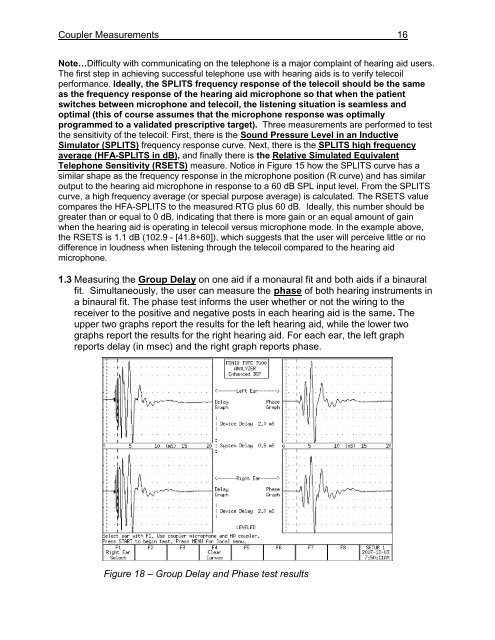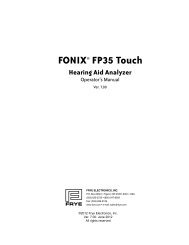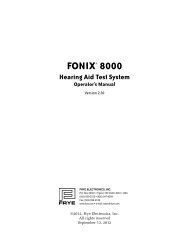Using the FONIX 7000 to Verify Coupler and Real-Ear Performance ...
Using the FONIX 7000 to Verify Coupler and Real-Ear Performance ...
Using the FONIX 7000 to Verify Coupler and Real-Ear Performance ...
You also want an ePaper? Increase the reach of your titles
YUMPU automatically turns print PDFs into web optimized ePapers that Google loves.
<strong>Coupler</strong> Measurements 16<br />
Note…Difficulty with communicating on <strong>the</strong> telephone is a major complaint of hearing aid users.<br />
The first step in achieving successful telephone use with hearing aids is <strong>to</strong> verify telecoil<br />
performance. Ideally, <strong>the</strong> SPLITS frequency response of <strong>the</strong> telecoil should be <strong>the</strong> same<br />
as <strong>the</strong> frequency response of <strong>the</strong> hearing aid microphone so that when <strong>the</strong> patient<br />
switches between microphone <strong>and</strong> telecoil, <strong>the</strong> listening situation is seamless <strong>and</strong><br />
optimal (this of course assumes that <strong>the</strong> microphone response was optimally<br />
programmed <strong>to</strong> a validated prescriptive target). Three measurements are performed <strong>to</strong> test<br />
<strong>the</strong> sensitivity of <strong>the</strong> telecoil: First, <strong>the</strong>re is <strong>the</strong> Sound Pressure Level in an Inductive<br />
Simula<strong>to</strong>r (SPLITS) frequency response curve. Next, <strong>the</strong>re is <strong>the</strong> SPLITS high frequency<br />
average (HFA-SPLITS in dB), <strong>and</strong> finally <strong>the</strong>re is <strong>the</strong> Relative Simulated Equivalent<br />
Telephone Sensitivity (RSETS) measure. Notice in Figure 15 how <strong>the</strong> SPLITS curve has a<br />
similar shape as <strong>the</strong> frequency response in <strong>the</strong> microphone position (R curve) <strong>and</strong> has similar<br />
output <strong>to</strong> <strong>the</strong> hearing aid microphone in response <strong>to</strong> a 60 dB SPL input level. From <strong>the</strong> SPLITS<br />
curve, a high frequency average (or special purpose average) is calculated. The RSETS value<br />
compares <strong>the</strong> HFA-SPLITS <strong>to</strong> <strong>the</strong> measured RTG plus 60 dB. Ideally, this number should be<br />
greater than or equal <strong>to</strong> 0 dB, indicating that <strong>the</strong>re is more gain or an equal amount of gain<br />
when <strong>the</strong> hearing aid is operating in telecoil versus microphone mode. In <strong>the</strong> example above,<br />
<strong>the</strong> RSETS is 1.1 dB (102.9 - [41.8+60]), which suggests that <strong>the</strong> user will perceive little or no<br />
difference in loudness when listening through <strong>the</strong> telecoil compared <strong>to</strong> <strong>the</strong> hearing aid<br />
microphone.<br />
1.3 Measuring <strong>the</strong> Group Delay on one aid if a monaural fit <strong>and</strong> both aids if a binaural<br />
fit. Simultaneously, <strong>the</strong> user can measure <strong>the</strong> phase of both hearing instruments in<br />
a binaural fit. The phase test informs <strong>the</strong> user whe<strong>the</strong>r or not <strong>the</strong> wiring <strong>to</strong> <strong>the</strong><br />
receiver <strong>to</strong> <strong>the</strong> positive <strong>and</strong> negative posts in each hearing aid is <strong>the</strong> same. The<br />
upper two graphs report <strong>the</strong> results for <strong>the</strong> left hearing aid, while <strong>the</strong> lower two<br />
graphs report <strong>the</strong> results for <strong>the</strong> right hearing aid. For each ear, <strong>the</strong> left graph<br />
reports delay (in msec) <strong>and</strong> <strong>the</strong> right graph reports phase.<br />
Figure 18 – Group Delay <strong>and</strong> Phase test results
















